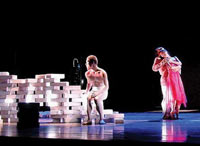| The Little Company that Could |
| http://www.sina.com.cn 2005/01/07 20:40 thats China |
 The Little Company Of the company's New York debut in 2001, New York Times Dance critic Anna Kisselgoff wrote, "It's easy to be astonished by the sheer physical power of these absolutely brilliant dancers. They have a spring in their leap, a fluidity and suppleness that bring something new to movements that might otherwise look familiar." Australian choreographer Frances d'Ath did a residency with the company two years ago, and describes the eleven members as "among the best in the world." "Their freedom comes from the fact that they're willing to try anything, unlike in America, where they have 60 years of Martha Graham to fight against," says d'Ath, referencing the seminal American dancer, chorographer and teacher who was the single greatest influence on Modern Dance, but who also perhaps unwittingly drew its boundaries. "They're making dance history at the moment - and not just Western dance with a Chinese feel, but really creating a whole new aesthetic." Yet the Guangdong Modern Dance Company has arguably done a much better job of winning the respect of the world than that of its own backyard. Though highly revered in Beijing and Shanghai, with a small but loyal following in Guangzhou, the average Chinese person still sees them as incomprehensible.
"Are you aliens?" laughs Zhou Fong, making a "deer-in-the-headlights" face to describe the reaction the company got while touring smaller cities and villages around Guangdong a few years ago. "Dance is very popular in China," says Ou. "With one exception: Modern Dance. Most people think Modern Dance is what people do in pop song videos - something strictly for entertainment. But I see it as a totally pure art form." The night of the performance, the symphony hall is filled to capacity. As conductor Yang Yang cues the music, no one, including the dancers themselves knows exactly what to expect as they disperse into the theater, wearing elaborate costumes, dancing on raised platforms and in the aisles. The audience looks confused - not quite "deer-in-the-headlights" dumbfounded, yet clearly unsure of what's happening. In one scene, they parade in long, elegant robes of aristocracy, agonizingly forcing a near-naked Ou back into his garments. One recurring theme in the company's work is that of an individual fighting against an oppressive and accusatory society, shamed and humiliated as Adam and Eve realizing their own nudity for the first time. But just as often, their movements are soft as breath and graceful beyond words, the dancers' bodies elegant, ghost-like conduits of the music. When the lights go up, and the dancers come on stage for a bow, the applause is at first slow in forming - people seem to want to see if the person sitting next to them will clap. But by the end, half of the concert hall is standing in a rousing ovation. For the troupe, and its director Willie Tsao, who has invested his heart, soul and personal life savings into creating the company, the night is another in a long line of small but important victories. Modern Dance was, for all practical purposes, non-existent in China until 1987. During a trip to the US in 1986, then principal of the Guangdong Dance Academy Yang Mei-qi discovered Modern Dance and decided it should be adopted into the academy curriculum. The government's initial response was that Modern Dance was "subversive and unpatriotic." Yang refused to relent, however, eventually convincing the government to invite Hong Kong Contemporary Dance choreographer Willie Tsao to be their first instructor.
|
|
|
|
|
|
| Annotation |
| 新 闻 查 询 |
| 热 点 专 题 | ||||
| ||||
|
教育频道意见反馈留言板 电话:010-82619898-5747 欢迎批评指正
新浪简介 | About Sina | 广告服务 | 联系我们 | 招聘信息 | 网站律师 | SINA English | 会员注册 | 产品答疑
Copyright © 1996 - 2005 SINA Inc. All Rights Reserved
版权所有 新浪网![]() 北京市通信公司提供网络带宽
北京市通信公司提供网络带宽
